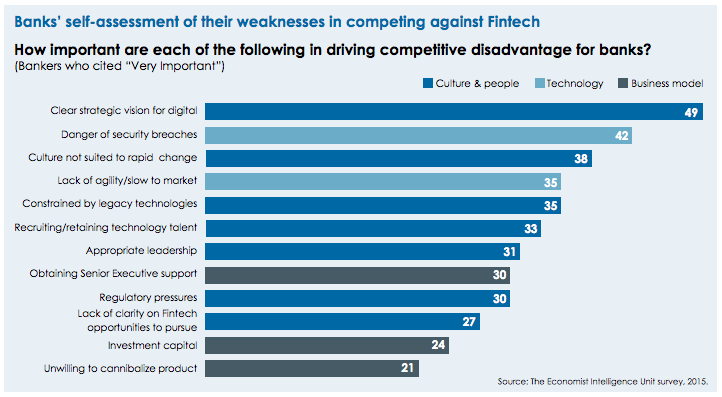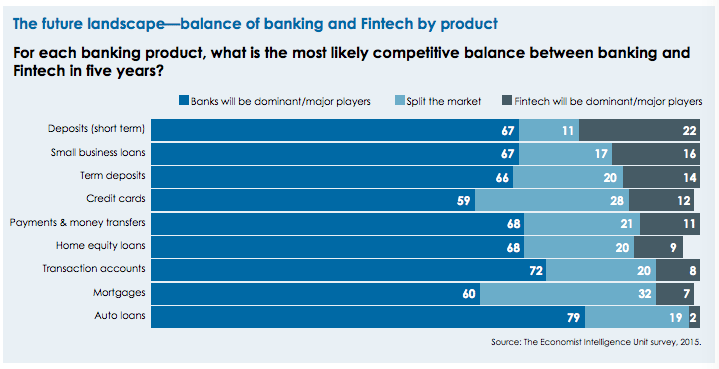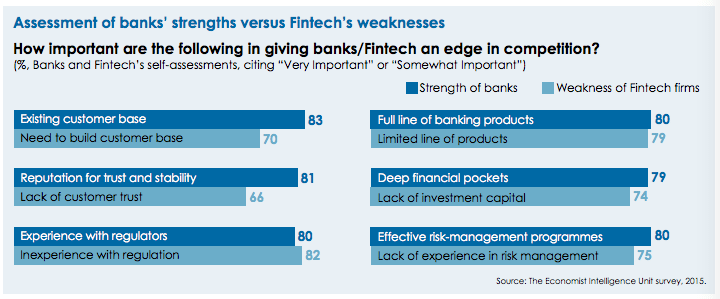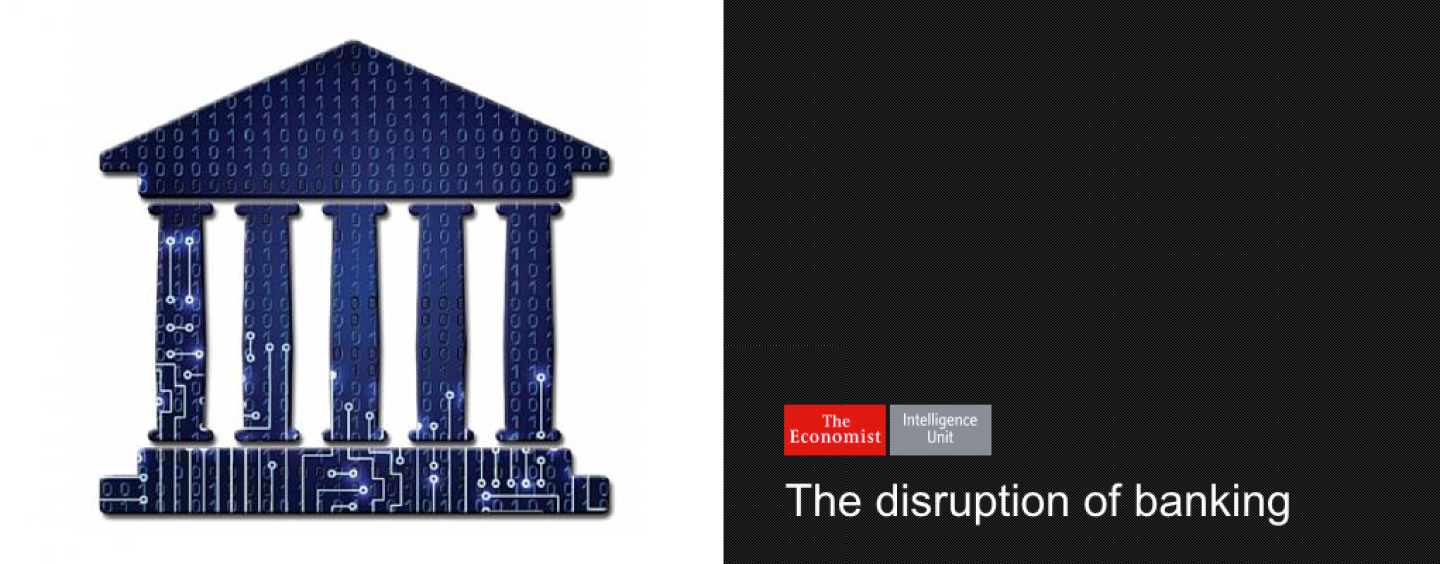Banks and fintech startups have more business interests in common than issues that divide them, according to a new report from The Economist Intelligence Unit (EIU).
The document, entitled ‘The Disruption Of Banking,’ is based on surveys of more than 100 senior bankers and 100 fintech executives and seeks to determine their respective views on the impact of financial technologies. It highlights the strengths and weaknesses of both banks and these new players and the likely outcome of the phenomena for the retail banking industry over the next five years.
Findings suggest that 33% of bankers predict the upcoming retail banking landscape as a mix – bank and fintech – environment, each dominating sectors, while startup executives majorly believe that banks will continue to dominate (46%).


On their weaknesses, fintech executives cited the lack of experience in risk management (27%) and the lack of necessary investment capital (25%). On the other hand, they self-assessed their strengths as being the limited product set (34%) and the absence of legacy systems (33%).
But more importantly, fintech’s greatest underlying strength is its culture, which provides an ability to move fast, to take risks and to innovate, the report claims.
While banks are advantaged by their reputation for stability (42%), their customers’ loyalty (41%) and their existing customer base (40%), bankers believe that their lack of a clear strategic vision for digital (49%), the danger of security breaches (42%) and the fact that the culture does not suit to rapid change (38%), are their main weaknesses.

Overall, fintech executives believe that banks will continue to be the dominant players in all the nine primary retail banking products in five years. However, they also said that all bank products are on the table for digital disruption, adding that new entrants will take a significant share.

Why banks and fintech startups need each other
Hence, the danger for banks is that innovative business models take a bite out of every part of their product portfolios. The report suggests that their smartest option is to embrace disruption and team up with fintech startups to create new product innovations and better experience for clients.
For fintech as well, collaborating with banks will be a critical step as they face important challenges. Scaling is one of them, as many of their business models require these startups to ramp up to millions of customers or transactions to make the return on investment work.
Another challenge is time, considering that many of these startups work under a venture capital model that funds them for just a few years.
Finally, if success does emerge, a difficult task will be to move from startup to being a real financial services firm, which will require taking on the regulators, becoming proficient in the art of risk management, ensuring data security and building the technology to support these capabilities.
Interestingly, when comparing the banks’ and fintech’s strengths and weaknesses to each other, the EIU found that there is a remarkable match between the strengths of banks and the weaknesses of fintech and conversely. This further stresses that collaboration is the logical next step.

The key to success for these startups will be “partnering well,” the EIU said, as only a lucky few of them will be able to marry their models to existing institutions with trusted brands, deep pockets, industry expertise and millions of customers will be the ones that pull ahead of their peers to achieve rapid scale. “The logical partners for the winners in Fintech will be the banks,” the report claims.
‘Fintegration’
As noted by Andres Wolberg-Stok, Global Head of Emerging Platforms and Services at Citibank: “The holy grail for banks is to become the best at ‘fintegration’.”
However, the main challenge of ‘fintegration’ is to preserve “the acquired company’s agility and innovation, while marrying it to the controls and assets of the bank.”
Hence, the EIU suggests six guidelines:
- Include IT in the due diligence and integration planning: an acquisition should not be closed without an “IT battle plan” that takes into consideration the current state, transformation plan and the future plan of the combined entities.
- ‘Ringfence’ the new culture: banks should consider ‘ringfencing’ the new entity – with its own leadership, compensation, rules and even physical location – in order to preserve its innovative mindset.
- Make regulatory integration an early priority: once a deal is closed, fintech employees should be on-boarded onto the bank’s compliance platform and have mandatory training sessions.
- Make data security an early priority: a security audit should be part of due diligence.
- Data integration: there should be a roadmap for the integration of data which should include a primary data management system that allows an integrated, common view of customers.
- Integration of enterprise infrastructures: this step comes last. The process of integrating the two infrastructures can be a stimulus for migration legacy systems to more cost-effective cloud networks.
Finally, the EIU projects that the dominant trend in retail banking over the next five years will be “banks’ co-option of fintech models.”
“We expect to see many of the same banking names in 5-10 years, but the way we receive banking services will have shifted,” the EIU writes.
It concludes:
“As is the case in so many disruptive events, the winner will be the consumer, who will receive lower prices, more innovative products and better service in a transformed banking world.”
Read the EIU’s ‘The disruption of banking’ full report: http://www.economistinsights.com/technology-innovation/analysis/disruption-banking








13 Comments so far
Jump into a conversationAppreciate if you team share the on going offering & features.
Banks and fintech companies are engaged in a dynamic competition for dominance in the financial services industry. While traditional banks offer stability, established infrastructure, and regulatory compliance, fintech firms excel in innovation, agility, and user-friendly experiences. Both sides strive to leverage technology and customer-centric approaches to meet evolving financial needs and reshape the future of banking.